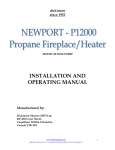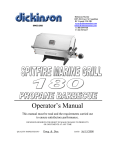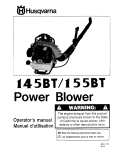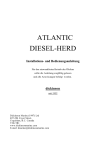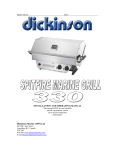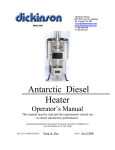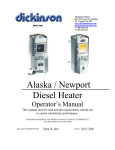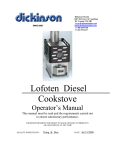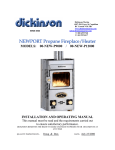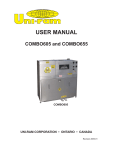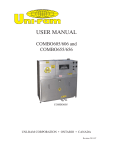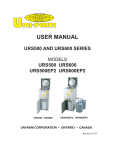Download Dickinson Newport Specifications
Transcript
INSTALLATION AND OPERATING MANUAL This manual MUST be read carefully and all requirements carried out to ensure satisfactory performance dickinson since 1932 Dickinson Marine (1997) Ltd 407-204 Cayer Street, Coquitlam, B.C. Canada V3K 5B1 www.dickinsonmarine.com E mail [email protected] www.ahoycaptain.com Quality and service is remembered long after price is forgotten www.ahoycaptain.com 1 WARNINGS AND DISCLOSURES FOLLOW ALL INSTALLATION AND OPERATING PROCEDURES A PERMANENTLY OPEN FRESH AIR INLET MUST BE INSTALLED TO ALLOW AIR TO ENTER THE BOAT AND PROVIDE COMBUSTION AIR FOR THE STOVE THE DIESEL FUEL SUPPLY MUST BE FILTERED (The element or filter MUST be changed every year) A BAROMETRIC FLUE DAMPER MUST BE INSTALLED IN FLUE STACKS LONGER THAN 6 FEET DO NOT USE SUBSTITUTE PARTS AFTER START-UP THE FLAME MUST BURN ABOVE THE 6" BURNER RING AT ALL TIMES. THE FLAME MUST NOT BURN BELOW THE RING - INSIDE THE BURNER. EXCESS HEAT AND RAPID CARBON BUILD-UP WILL OCCUR. DO NOT OPERATE THIS PRODUCT UNATTENDED LIGHTING INSTRUCTIONS 1. 2. 3. 4. 5. 6. 7. 8. 9. Open the door Turn the oil metering valve ON and allow about 30ml (2 tbls) of oil into the burner TURN THE OIL METERING VALVE OFF Light the oil with a piece of lighted tissue Replace the top lid Turn the COMBUSTION FAN to LOW SPEED NOTE : If the flame goes out after this stage DO NOT RE-LIGHT FOR 15 MINUTES The priming fuel will vaporize in 5-10 minutes. When priming fuel is almost gone turn the OIL METERING VALVE ON to the lowest setting to BRING THE FLAME ABOVE THE BURNER RING When the flue stack is hot (15-20 mins) the COMBUSTION FAN may be turned OFF kept on at low speed. Keep at low fire for 30 minutes before selecting higher settings. INCREASE FUEL ONE INCREMENT AT A TIME. CAUTION : NEVER LIGHT A FLOODED BURNER www.ahoycaptain.com 2 3" diameter DP Flue Cap TYPICAL INSTALLATION NEWPORT HEATER 3" Thru-Deck Fitting Dress Ring 4 ft minimum Max 45 degrees Hot Water Outlet 3" diameter Pipe Pressure Relief Valve Barometric Draft Damper Hot Water Tank Cold Water Outlet 12"-24" 3/8" Vent Gravity Fuel Tank Check Valve Water Pump Min 12" Filter and Shut-Off Valve Valve Fuel Level 3/8" Copper Fuel Line From Main Water Tank To Main Water Tank Fuel Pump less than 4 psi Overflow return to main tank or container Fuel from Main Tank 3 www.ahoycaptain.com RECOMMENDED INSTALLATION REQUIREMENTS – NEWPORT HEATER 45 degree max Elbows 1/2" Spacers 3” Barometric Damper 12” High Heat Insulation Stainless Wall Liner Drip Tray Permanently open fresh air inlet 3/8”Copper Fuel Line Overflow www.ahoycaptain.com 4 INSTALLATION LOCATION The space for the location of your Newport heater must be large enough to provide the required clearances (see installation diagrams - Pages 2 and 3). It must be lined with high density, heat retardant insulation and finished with a light gauge metal, preferably stainless steel. Particular care must be taken to protect the surfaces close to the edge of the top cooking surface and the chimney stack. The location should also take into account the length and configuration of the flue stack. Ideally your Newport should face the bow or the stern however, in most installations, the stove faces port or starboard. Fuel gravity feeds from the oil-metering valve into the burner. Should this valve drop below the level of the burner fuel will not flow into the burner and the fire will go out. In a fore and aft SAILBOAT installation or in a fore and aft installation in a boat which will list or heel for any length of time THE OIL METERING VALVE MAY REQUIRE TO BE RE-LOCATED EXTERNALLY ON THE LEFT OR RIGHT SIDE OF THE HEATER. If you have are in doubt regarding the need for a valve re-location please ask your dealer or call dickinson on our 800 number. MOUNTING AND SECURING 1) 2) The heater must be and secured through the bolt holes on the rear mounting bracket. The finishing tray (supplied) must be installed under the heater FLUE STACK The length and straightness of the flue stack are important to the efficient operation of the stove Diameter Recommended Length Notes - 3 ins (7.62cm) 3 ft ( 1m) Stack must be correct diameter Elbows in excess of 45 degrees not recommended Elbows greater than 45 degrees MUST not be used. A Barometric Damper is recommended for all installations but must be installed in flue stacks longer than the recommended lengths The ROUND pipe is squeezed to fit the OVAL flue collar on the stove THROUGH DECK FITTING Through Deck-Fitting Gasket or Sealing Compound Teak Leveling Block Internal Dress Ring Deck www.ahoycaptain.com FLUE CAP 5 The Dickinson DP or H style flue caps are recommended. The location of the flue cap above deck must be clear of any immediate obstruction that may cause unusual air movement or turbulence. CAUTION : The Flue Cap gets hot when the stove is operating. OIL - SUPPLY Oil is supplied to the oil-metering valve of the heater from a gravity feed tank or by a low-pressure pump direct from the main fuel tank. (See Typical Installation diagram - Page 2) UNDER NO CIRCUMSTANCES MUST HOLES BE DRILLED IN THE DRIP PAN. GRAVITY A minimum head of fuel 12" (30.48 cm) above the fuel level marked on the side of the oil-metering valve is required to operate the oil-metering valve. DO NOT USE A PRESSURIZED FUEL TANK. The gravity feed tank must be vented and all fuel lines must be as straight as possible to avoid air locks. USE 3/8" (9.52 mm) COPPER FUEL LINE ONLY PRESSURE A low pressure pump (less than 4 psi) must be plumbed directly from the main fuel tank. The fuel inlet is a 3/8" flare fitting. DO NOT TAKE THE STOVE FUEL SUPPLY OFF THE ENGINE SUPPLY OR RETURN LINE USE 3/8" (9.52 mm) COPPER FUEL LINE ONLY. A FUEL FILTER must be installed in the fuel supply line. THIS FILTER OR FILTER ELEMENT MUST BE CLEANED OR REPLACED AT LEAST EVERY YEAR. A POSITIVE SHUT-OFF VALVE MUST be located in the fuel supply line close to the stove. OIL METERING VALVE (See exploded view diagram - Page 6) IMPORTANT NOTE : THE OIL METERING VALVE OVERFLOW MUST NOT BE PLUGGED UNDER ANY CIRCUMSTANCES. A fuel line should be taken from the overflow to a container situated away from the heats source. This tank should be checked periodically for oil. UNDER NORMAL OPERATING CONDITIONS NO FUEL WILL ESCAPE THROUGH THE OVERFLOW. FUEL DRIPPING FROM THE OVERFLOW INDICATES DIRT IN THE LINE. IF THIS HAPPENS THE STOVE WILL CONTINUE TO BURN NORMALLY. THE OIL METERING VALVE REQUIRES CLEANING AND REPAIR. Thermal Mechanical www.ahoycaptain.com Safety Shut-Off OIL METERING VALVE 5/64ths allen wrench fuel flow adjusting screw. Adjust from top of knob. 6 5/64ths allen wrench securing screw Metering Stem Spring Circlip 1/8" NPT Mesh Screen on fuel "O"Ring Metering Slot Fuel Inlet Needle and Seat 3/8"Flare Float Float Hinge and Needle Activator Fuel Oil Level Indication Bar Fuel Oil Level Overflow OverflowTube Metering Stem Guide Safety Overflow to container or back to main fuel tank Fuel Outlet to www.ahoycaptain.com 7 FUEL - CONSUMPTION The Oil Metering Valve flow rate has been set at the time of manufacture. _____________________________________________________________________________________ Low Fire cc/minute cc/hour 4 240 litres/24 hours 5.86 gallons/ 24 hours 1.29 High Fire 10 600 14.54 3.20 _____________________________________________________________________________________ FUEL - VARIATIONS It is unlikely that the fuel you are using is the same viscosity as the fuel used to calibrate the oil-metering valve. Fuel viscosity differs on a routine basis even though you purchase the same grade of oil from the same supplier. Factors influencing oil viscosity : Oil company quality adjustments and refinements and oil temperature The oil metering valve is calibrated for #2 diesel (unless you requested otherwise.) Burning diesel #1 (stove oil) will allow 25% more fuel and burning kerosene will allow 50% more fuel to flow through the oil-metering valve. IT IS IMPORTANT TO BURN THE FUEL FOR WHICH THE VALVE WAS CALIBRATED By studying the burning characteristics (see Operation) it can be determined whether the fire is too high or too low. FUEL - FLOW MEASUREMENT If your heater is burning too hot or not hot enough you can measure the oil flow and adjust the flow to obtain the fuel consumption rates shown above. The procedure for this is as follows:1) Unscrew the flare nut and remove the fuel line. The brass coupling should be held with a wrench when unscrewing the nut to prevent the copper line from twisting 2) Turn the valve knob to the 1 setting. 3) Measure the oil quantity of oil dripping slowly from the outlet. The following measurements should be obtained Knob Setting 1 - 1 teaspoon in 60 seconds (4 c.c.'s per minute) Knob Setting 5 - 1 teaspoon in 20 seconds (10 c.c.'s per minute) If these flow rates are not correct the grade or viscosity of the oil will be the most likely cause. (See Oil Flow Adjustment - Page 8) www.ahoycaptain.com FUEL - OIL FLOW ADJUSTMENT 8 Refer to Oil Metering Valve diagram (Page 5) The height of the valve-adjusting knob will determine the quantity of oil exiting from the valve outlet. The oil flow adjustment can be made when checking the oil flow (as above) or when the heater is operating. Requirements Procedure - 5/64th ins allen wrench 1) On top of the valve knob - insert the allen wrench into the adjusting screw. Turn counterclockwise and remove the small jamming set screw. 2) Set the valve knob at #1 3) Re-insert the allen wrench into the adjusting screw. 4) Turn the allen wrench counterclockwise to decrease the fuel flow and clockwise to increase the fuel flow. We suggest no more than half turn adjustments each time until the desired flow rate is achieved. 6) Replace the jamming set screw. Prevent movement of the adjusting screw, which you have just set, by holding it. OIL METERING VALVE - SAFETY FEATURES 1) OVERFLOW is designed to prevent to much oil from entering the burner should there be dirt in the line and the valve. 2) FLAME-OUT - If the flame is extinguished with the oil metering valve open the float in the valve will shut-off the flow of oil into the burner. Oil will accumulate in the burner to a depth of 5/8 ins before the shut-off occurs. THIS OIL MUST BE REMOVED BEFORE RE-LIGHTING. 3) HIGH TEMPERATURE - The adjusting screw on the knob of the oil metering valve s fitted with a fusible sleeve. This fuse will melt if the valve knob reaches a temperature of 165 degrees F. This will shut-off the flow of oil into the burner. . Under normal conditions the valve is at room temperature. If the high fire sleeve melts it indicates too much heat in the valve compartment. THIS IS CAUSED BY INCORRECT OPERATING PROCEDURES. THE FLAME MUST BURN ABOVE THE BURNER RING AT ALL TIMES. If this occurs a replacement part is available from Dickinson. DO NOT LEAVE YOUR HEATER BURNING UNATTENDED www.ahoycaptain.com COMBUSTION AIR 9 To guarantee that sufficient oxygen (fresh air) is available for your stove, GOOD VENTILATION IS ESSENTIAL. It is necessary to replace the air inside your boat at the same rate that the stove is removing it. THE HOTTER THE HEATER THE MORE AIR IT WILL REQUIRE. As most boats are relatively air tight a SEPARATE, PERMANENTLY OPEN, FRESH AIR INLET IS RECOMMENDED. This inlet must be at least 3 " in diameter. Ducting fresh air to the stove is most satisfactory. It is important to create and maintain a positive pressure inside the boat. High winds can draw air from the boat and thus create a negative pressure. This condition can result in downdrafts. WE RECOMMEND THE INSTALLATION OF A CO2 ALARM SYSTEM. DO NOT LEAVE YOUR HEATER BURNING UNATTENDED COMBUSTION ASSIST FAN (CE Certified) YOUR HEATER IS A NATURAL DRAFT HEATER AND WILL OPERATE WITHOUT THE COMBUSTION ASSIST FAN The combustion assist fan must be used as follows :1) 2) 3) 4) To speed start-up and pre-heating. To ensure complete combustion and avoid flooding the burner when the fuel supply is turned up too quickly. To limit the effects of back draft should this occur during windy conditions. To operate the heater at high fire settings without carboning or smoking. On/Off Rocker Switch Red Wire Variable Speed Potentiometer 2amp fuse (not supplied) Battery Black wire Combustion Assist Fan www.ahoycaptain.com WATER HEATING (OPTIONAL) 10 The heater can be equipped with a single hot water heating coil. This optional item should be installed at time of manufacture but can be retrofitted later. Specifications - Coil 5/8th ins O.D. stainless steel tubing Single Turn heats 6-10 gallon tank TYPICAL WATER HEATING INSTALLATION Pressure Relief Valve Hot Water Tank Hot Water Heating Coil Check Valve Diesel Stove or Heater Pump MAIN WATER TANK www.ahoycaptain.com OPERATION 11 Preliminary Check-List a) Remove all plastic coating b) Open shut-off valve from gravity feed tank or switch on pressure pump to allow oil to flow to the oil metering valve c) Check all fuel line connections for leaks d) Check oil metering valve overflow outlet. overflow it indicates:- If oil drips out of the i) Sediment in the valve needle and seat. ii) Valve float not free. iii) Excess pump pressure (more than 4 psi.) Tapping the side of the valve may correct the problem. e) ASSEMBLE THE BURNER AS DIAGRAM 6" dickinson AIRFLOWBURNER Stove Top Combustion Chamber Superheater 9 Secondary Air Inlet Slots (Obround) Burner Ring. Installed with lip down Primary Air Inlet Holes (3 Rows) Primary Air Inlet Holes (1 Row - pointing down at 45 degrees) Fuel Inlet www.ahoycaptain.com LIGHTING PROCEDURE 12 See Page 1 of manual The first time the oil-metering valve is turned on it will take 5-10 minutes for the fuel lines to fill and oil to appear in the bottom of the burner. The burning characteristic of the flame during lighting is as follows :Lighting (Primed) Preheating Fuel Vaporizing Priming Fuel Burned Low Fire (Turn oil valve back on to 1 setting before fire goes out) The flame colour must be lemon yellow with no smoke emitted. If the flame does not rise above the burner ring when the oil metering valve is turned on increase the setting until it does. OPERATION TIP SELECT VALVE SETTING AND, WITH THE COMBUSTION ASSIST FAN, ADD AS MUCH AIR AS YOU CAN UNTIL THE FLAME SINKS BELOW THE BURNER RING. THEN BACK OFF THE FAN SPEED UNTIL THE FLAME IS OUT OF THE BURNER. THE FLAME MUST BURN ABOVE THE BURNER RING AT ALL TIMES FOR EFFICIENT COMBUSTION CAUTION - DO NOT LIGHT A HOT BURNER - DO NOT USE GASOLINE OR OTHER HIGHLY FLAMMABLE MATERIAL TO START THE BURNER CAUTION - DO NOT LIGHT A FLOODED BURNER www.ahoycaptain.com 13 A vaporizing oil burner of this type can be flooded if care is not taken to prevent excess oil entering the burner. By following the lighting instructions flooding will be avoided. Causes of burner FLOODING : (a) (b) (c) (d) Fuel entering the burner faster than it is burning. Increasing the fuel supply too quickly without use of the combustion assist fan. Poor draft and/or ventilation. Fire extinguishing and oil accumulating in the burner to a depth of 5/8th" until before the oil metering valve shuts-off. CAUTION - NEVER LIGHT A FLOODED BURNER - 6,500 BTU's 16,250 BTU's HEATING Heat Output - Low Fire High Fire The heater is designed to burn for long periods of time. Once the boat is up to temperature, it is only required to replace the heat being lost. It will therefore operate at low fire for most of the time and the heat produced will adequately heat most vessels up to 45 ft except when temperatures are extremely cold. SERVICE AND MAINTENANCE OIL METERING VALVE - Cleaning (Refer to diagram) THE FUEL FILTER MUST BE CLEANED ONCE A YEAR 1) Detach the copper fuel lines from the valve inlet, outlet and overflow and remove the valve from the mounting bracket. 2) Unscrew the two top screws and remove the top. The valve top and knob are attached 3) Remove the float pin Remove the needle Remove the needle and seat with a 5/16 ins wrench 4) Using the float pin push through the needle housing removing the rubber needle seat. Clean and replace in the brass housing grooved side up 5) Remove brass inlet elbow and clean the screen. 6) Tighten the brass needle seat in the valve top and replace the needle www.ahoycaptain.com 7) Replace the float - Replace the float pin - Replace the top and tighten the screws 14 DO NOT LIGHT THE STOVE UNTIL FLOW RATE HAS BEEN CHECKED (See Page 8) BURNER Carbon accumulates in the burner over a period of time and it must be cleaned routinely. If you are burning good quality fuel and the stove is burning efficiently this cleaning procedure will only be required once a year. IF THERE IS CARBON BUILD UP INSIDE THE BURNER THERE IS A COMBUSTION PROBLEM AND YOU MUST REFER TO THE TROUBLE-SHOOTING SECTION OF THIS MANUAL Cleaning Procedure 1) 2) 3) 4) 5) 6) Remove the stove lid and remove the burner ring and superheater Insert the reamer tool (provided) into the fuel inlet hole. This will prevent loose carbon falling into the fuel inlet during cleaning. With a wire brush, scrape any loose carbon from the sides of the burner. Using a paper lip poke out the four rows of air intake holes on the side of the burner to ensure that they are clear. Remove any loose carbon from the base of the burner. Remove the reamer and replace the burner ring and superheater. Make sure that the superheater has the small hole end down and that the ring is lip down. FUEL LINES Any blockage in the fuel line from the oil-metering valve to the burner can be cleaned by removing the clean-out plug situated directly under the burner. The plug must be replaced with tape sealant and checked for leaks. COMBUSTION CHAMBER This is the cemented area above the burner where the flame burns. The cement will show hairline cracks immediately on firing the stove. These cracks will not affect the burning of the stove. Re-lining the combustion chamber will only become necessary if the cement becomes loose or detached. Replacement cement is available from your dealer. OVEN CLEAN OUT Carbon may build-up around the oven. Carbon on top of the oven can be removed through the lid. To remove carbon under the oven, remove the front panel of the stove and access the clean-panel under the oven opening. www.ahoycaptain.com TROUBLE-SHOOTING 15 NO FUEL OR INSUFFICIENT FUEL TO THE BURNER Cause Remedy Fuel filter plugged Fuel line blocked Clean Establish how far fuel has reached. Start at the burner and work back to the fuel tank. Air Lock in fuel line Check all fuel line fittings. There should be no loops or sharp bends in the fuel line. Straighten lines. Tap with blunt object to relieve air lock. Water in fuel line and valve If fuel is not filtered water may accumulate in fuel line loops and bends. If a pressure pump is used water blockage will be in the oil-metering valve or between the valve and the burner. Water MUST be filtered from fuel. Fuel lock in gravity tank vent If gravity tank vent is used as overflow for the tank fuel may accumulate in loops and bends and block the vent. Straighten the vent line. B) EXCESS FUEL TO THE BURNER Fuel pump pressure greater than 4 psi Metering thinner fuel Pressure build-up in gravity feed tank Reduce pump pressure Check fuel flow (See Fuel-Flow Measurement). Adjust oil-metering valve accordingly. The diameter of the gravity tank overflow pipe must be the same or greater than the inlet line. Note : If any of the above occurs, excess oil will escape through the oil metering valve overflow. DO NOT PLUG THE VALVE OVERFLOW C) CARBON BUILD-UP/SOOTING AND SMOKING Most carboning problems occur from burning the stove too low causing rapid carbon build-up inside the burner (below the ring). The burner air intake holes become plugged preventing or restricting combustion air from entering the burner. This results in a lazy, orange flame above the ring, smoking and carboning. THE STOVE MUST BE BURNED HOT ENOUGH TO VAPOURIZE THE FUEL AND KEEP THE FLAME ABOVE THE RING. NOTE : CARBONING INSIDE THE BURNER (BELOW THE RING) Caused by : Not enough fuel or too much draft CARBONING ABOVE THE BURNER (CEMENTED COMBUSTION CHAMBER) Caused by : Too much fuel or not enough draft or air www.ahoycaptain.com Cause Remedy 16 Not Enough Air or Draft Negative inside pressure Negative inside pressure when engine is running Flue stack elbows greater than 45 degrees Check fresh air inlets Provide adequate engine air supply Revise flue stack configuration Too Much Draft Long stack Running combustion assist fan when not required Increased stack diameter D) Do not operate combustion assist fan Reduce stack to specified diameter DOWNDRAFT/BACKDRAFT Not enough fresh air inlets High winds Burning too low with flame inside burner - below ring Air turbulence at flue cap E) Reduce stack length or install barometric damper Provide permanently open fresh air inlet Increase fuel supply and operate combustion assist fan at low or medium speed. Note : the flame must remain above the burner ring at all times. Increase fuel Re-locate flue outlet or extend flue pipe clear of any obstruction. RELEASE OF HIGH FIRE FUSIBLE LINK ON VALVE Excess heat in valve area Poor natural draft Poor boat ventilation Unnecessary use of combustion assist fan Flame inside pot for long periods Check stack length and configuration Check supply of fresh air Keep flame above burner ring when using fan Keep flame in combustion chamber above burner www.ahoycaptain.com LIMITED WARRANTY 17 WARRANTY PROVISIONS : dickinson warrants this product to be free of defects in workmanship and materials for a period of one year. This warranty is limited to claims submitted in writing within a one-year period following the date of purchase. If any part of your new product fails because of a manufacturing defect within the warranty period dickinson offers to replace said parts free of charge, provided, however, that such parts have not been improperly repaired, altered or tampered with or subjected to misuse, abuse or exposed to corrosive conditions. This warranty, however, is limited by certain exclusions, time limits and exceptions as listed below. Read these limitations and exclusions carefully. TIME LIMIT : This warranty is given too and covers only the original purchaser. Coverage terminates one year from the date of purchase for parts replacement. EXCLUSIONS : This warranty does not cover or include : (a) Any normal deterioration of the product and appearance of items, due to wear and/or exposure; (b) any guarantees, promises, representations, warranties or service agreements given or made by an authorized distributor or other person selling this product, other than those specifically stated herein; (c) any damage or defect due to accident, improper repair, alteration, unreasonable use including failure to provide reasonable and necessary maintenance, misuse or abuse of the equipment, or exposure to corrosive conditions. This warranty is conditioned upon normal use, reasonable and necessary maintenance and service of your product, and written notice being given promptly upon Buyer's discovery of a warranty claim, pursuant to paragraph 6 below. Reasonable and necessary maintenance is maintenance which you are expected to do yourself or have done for you. It is maintenance, which is necessary to keep your product performing its intended function and operating at a reasonable level of performance. DAMAGE LIMITATION WARNING : IN NO EVENT SHALL dickinson BE LIABLE FOR ANY INCIDENTAL OR CONSEQUENTIAL DAMAGES, INCLUDING (BUT NOT LIMITED TO) LOSS OF USE OF THE PRODUCT, LOSS OF TIME, INCONVENIENCE, EXPENSES FOR TRAVEL, LODGING TRANSPORTATION CHARGES, LOSS BY DAMAGE TO PERSONAL PROPERTY OR LOSS OF INCOME, PROFITS OR REVENUE. ORAL OR IMPLIED WARRANTY LIMITATIONS : The foregoing warranty is exclusive and in lieu of all other warranties, written or oral, expressed or implied, including but not limited to any warranty or merchantability or fitness for a particular purpose. TRANSFER LIMITATIONS : This warranty is not assignable or transferable. It covers only the original purchaser. CLAIM PROCEDURE : In the event of a defect, problem or that a breach of this warranty is discovered, in order to protect any warranty rights you must promptly notify dickinson. Give name, address, and model name, location of unit, description of problem and where you can be reached during business hours. RESERVED RIGHT TO CHANGE : dickinson reserves the right to make changes or improvements to products it produces in the future without imposing on itself any obligations to install the same improvements in the products it has previously manufactured. SECOND OR SUBSEQUENT OWNER : dickinson does not give any warranty to secondary or subsequent purchasers, and it disclaims all implied warranties to such owners. INSPECTION : To assist you in avoiding problems with your product and to validate this warranty you are required to do the following : (a) read the warranty; (b) inspect the product. Do not accept delivery until you have examined the product with your supplier; (c) ask questions about anything you do not understand concerning the product. OWNER REGISTRATION : Fill out the WARRANTY CARD within 30 days from the date of delivery. WARRANTY : RETURN OF THE CARD IS CONDITION PRECEDENT TO WARRANTY COVERAGE AND PERFORMANCE. IF YOU DO NOT FILL OUT AND MAIL THE CARD AS DIRECTED, YOU WILL NOT HAVE A WARRANTY. LEGAL RIGHTS : This warranty gives you specific legal rights and you may also have other rights, which may vary within different government jurisdictions.


















